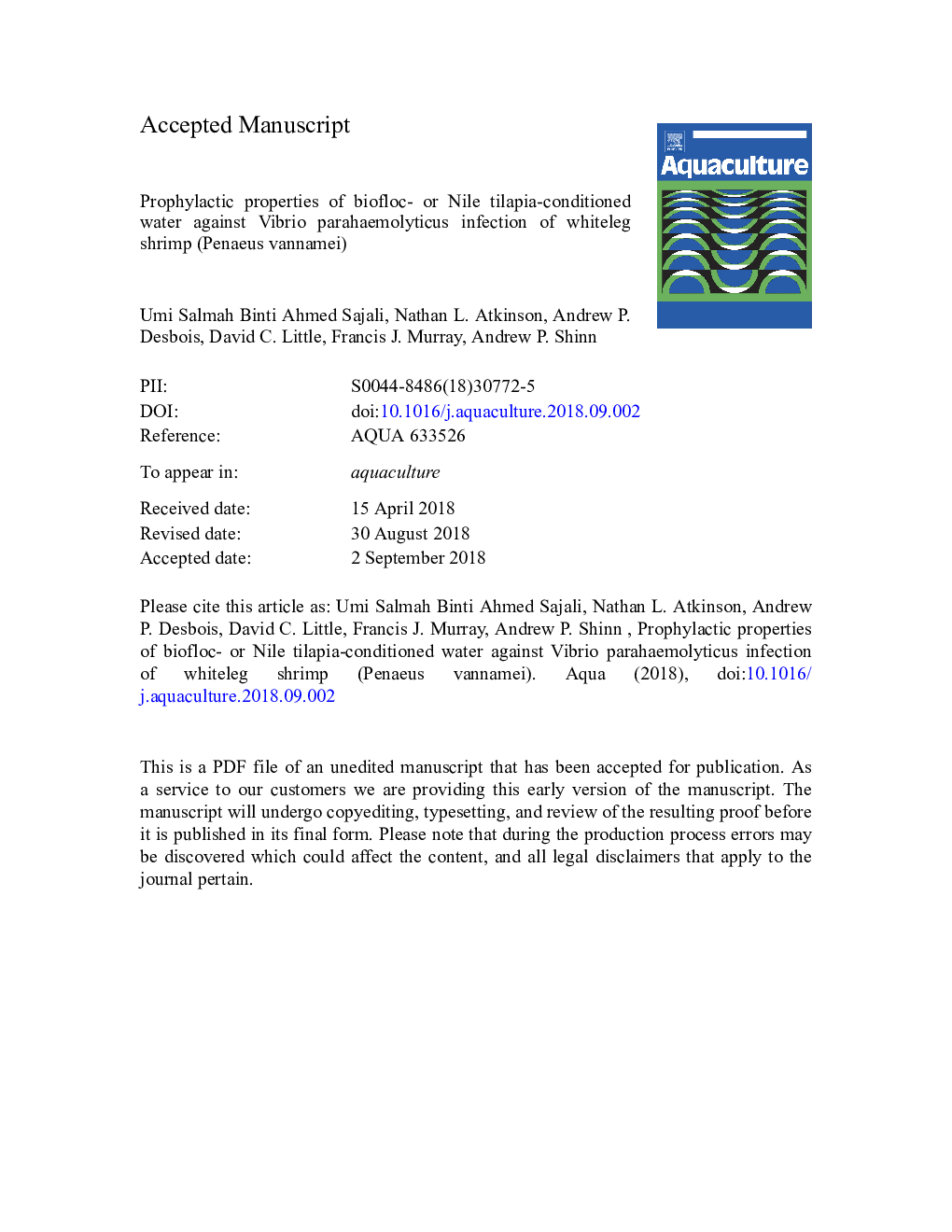| کد مقاله | کد نشریه | سال انتشار | مقاله انگلیسی | نسخه تمام متن |
|---|---|---|---|---|
| 11031921 | 1645731 | 2019 | 26 صفحه PDF | دانلود رایگان |
عنوان انگلیسی مقاله ISI
Prophylactic properties of biofloc- or Nile tilapia-conditioned water against Vibrio parahaemolyticus infection of whiteleg shrimp (Penaeus vannamei)
دانلود مقاله + سفارش ترجمه
دانلود مقاله ISI انگلیسی
رایگان برای ایرانیان
کلمات کلیدی
موضوعات مرتبط
علوم زیستی و بیوفناوری
علوم کشاورزی و بیولوژیک
علوم آبزیان
پیش نمایش صفحه اول مقاله

چکیده انگلیسی
Isolates of Vibrio parahaemolyticus (VpAHPND) that carry a plasmid encoding two Pir-like toxins cause acute hepatopancreatic necrosis disease (AHPND), a disease that has caused devastating economic losses to the shrimp industry, particularly in Asia. However, lower prevalence of AHPND infection has been associated with farms that operate with biofloc or lower salinity culture water. Therefore, the aim of this present study was to investigate the effects of biofloc and Nile tilapia (Oreochromis niloticus)-conditioned water prepared at different culture water salinities on survival of whiteleg shrimp (Penaeus vannamei) bath-challenged experimentally with VpAHPND. First, groups of shrimp were bath-challenged with VpAHPND in clear 15â¯ppt seawater (CW) or in the presence of a pre-cultured biofloc at 25%, 50% and 100% (v/v). Survival during 96â¯h post-challenge was significantly greater in groups cultured in 50% and 100% biofloc (pâ¯<â¯0.05). In a second trial, the effect of shrimp stocking density on biofloc protection against bath challenge with VpAHPND was determined and shrimp challenged in 100% biofloc again had significantly greater survival (pâ¯<â¯0.05) compared to the CW group, whilst under our experimental conditions stocking density had no significant influence on survival post-challenge. In a third trial, shrimp were challenged with VpAHPND in three different salinities of CW or Nile tilapia-conditioned (NTC) water (5â¯ppt, 10â¯ppt and 15â¯ppt). Survival in this final trial was 33% at 96â¯h in 5â¯ppt CW compared to just 7% in the 10â¯ppt and the 15â¯ppt CW groups, though these differences were not statistically significant. Moreover, shrimp survival in the 5â¯ppt and 10â¯ppt NTC water groups was significantly greater than in the 15â¯ppt NTC water group (pâ¯<â¯0.05), while significantly greater survival was observed in 10â¯ppt NTC water compared to 10â¯ppt CW (pâ¯<â¯0.05). The results indicate that biofloc and NTC water may provide some protection against AHPND, whilst low salinity culture water may also offer a degree of protection against this bacterium. These findings may allow for the implementation of inexpensive strategies in the shrimp industry to assist in minimising the impact of VpAHPND as part of pond management practices.
ناشر
Database: Elsevier - ScienceDirect (ساینس دایرکت)
Journal: Aquaculture - Volume 498, 1 January 2019, Pages 496-502
Journal: Aquaculture - Volume 498, 1 January 2019, Pages 496-502
نویسندگان
Umi Salmah Binti Ahmed Sajali, Nathan L. Atkinson, Andrew P. Desbois, David C. Little, Francis J. Murray, Andrew P. Shinn,